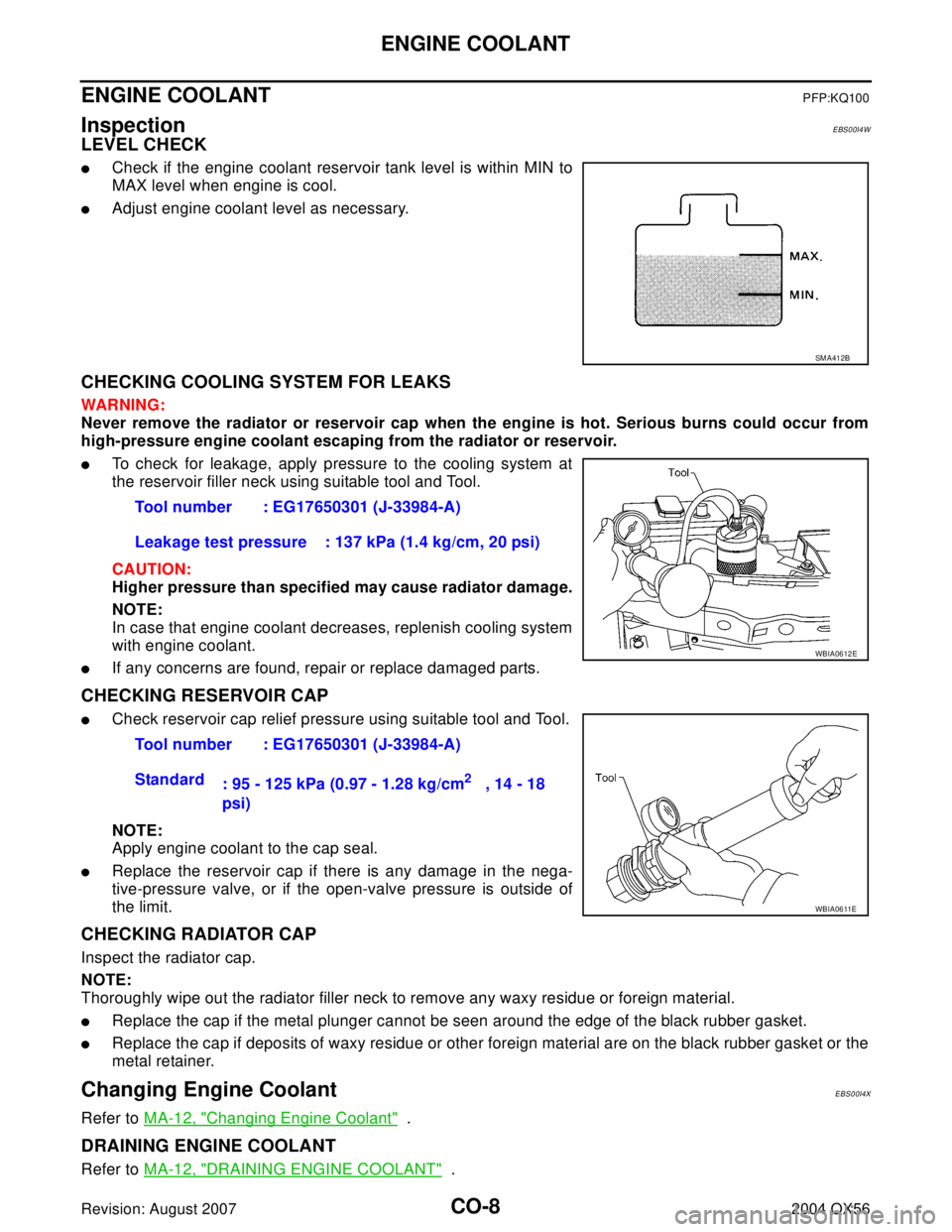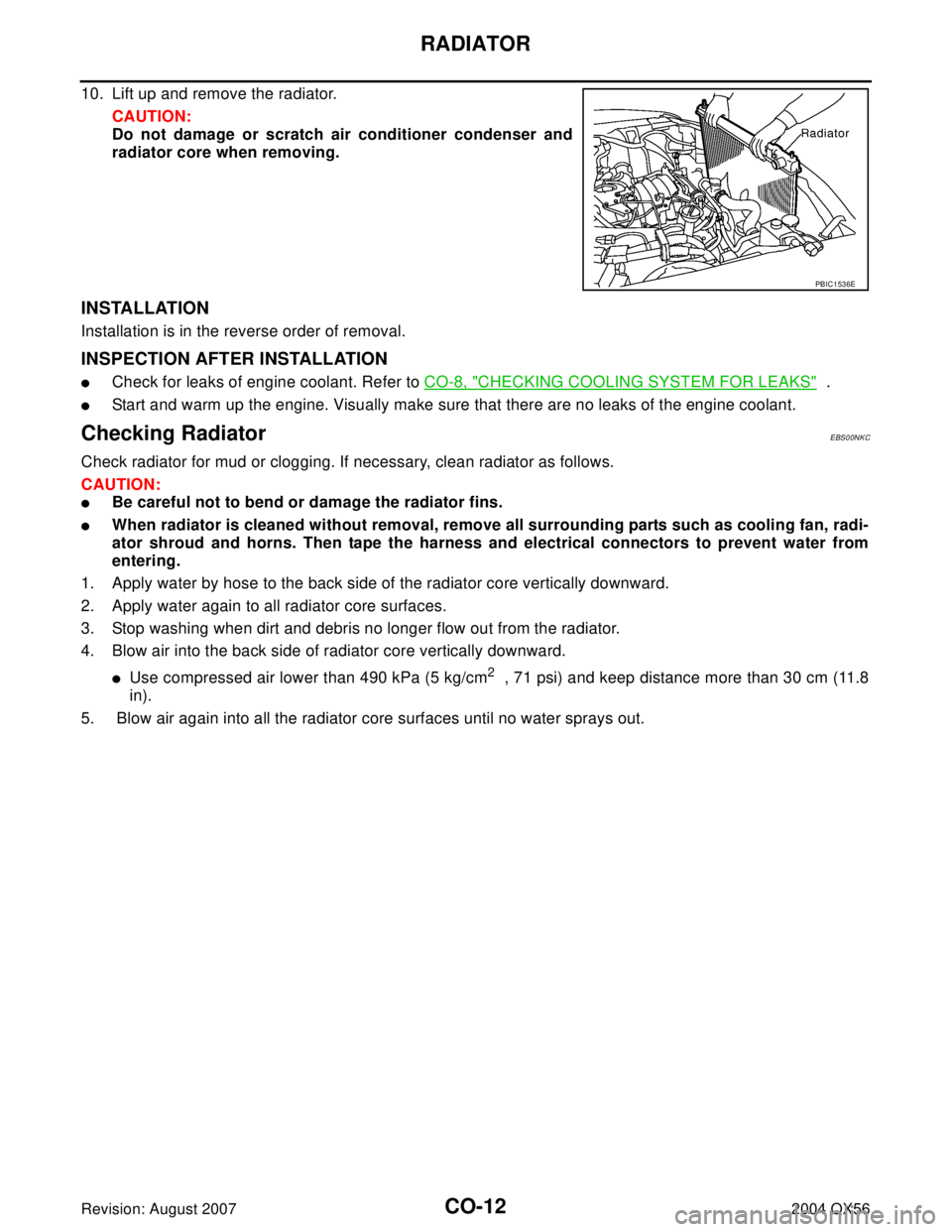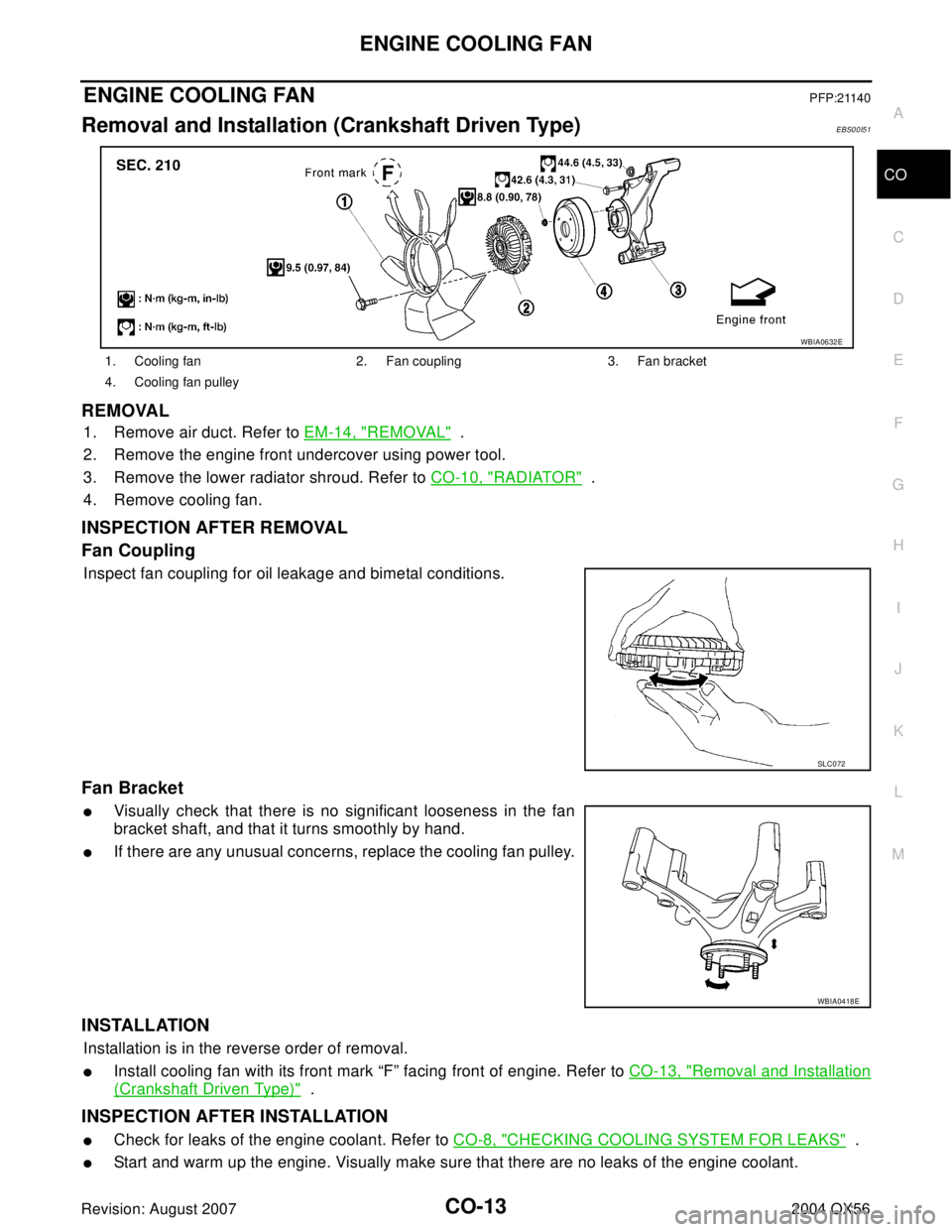Page 1087 of 3371

CO-4Revision: August 2007
OVERHEATING CAUSE ANALYSIS
2004 QX56
OVERHEATING CAUSE ANALYSISPFP:00012
Troubleshooting ChartEBS00I4T
Symptom Check items
Cooling sys-
tem parts
malfunctionPoor heat transferWater pump malfunction Worn or loose drive belt
— Thermostat stuck closed —
Damaged finsDust contamination or
paper clogging
Physical damage
Clogged radiator cooling
tubeExcess foreign material
(rust, dirt, sand, etc.)
Water cut valve malfunctionExcess foreign material
(rust, dirt, sand, etc.), phys-
ical damage
Reduced air flowCooling fan does not oper-
ate
Fan assembly — High resistance to fan rota-
tion
Damaged fan blades
Damaged radiator shroud — — —
Improper engine coolant
mixture ratio—— —
Poor engine coolant quality — Engine coolant density —
Insufficient engine coolantEngine coolant leaksCooling hoseLoose clamp
Cracked hose
Water pump Poor sealing
Radiator capLoose
Poor sealing
RadiatorO-ring for damage, deterio-
ration or improper fitting
Cracked radiator tank
Cracked radiator core
Reservoir tank Cracked reservoir tank
Overflowing reservoir tankExhaust gas leaks into
cooling systemCylinder head deterioration
Cylinder head gasket dete-
rioration
Page 1088 of 3371
OVERHEATING CAUSE ANALYSIS
CO-5
C
D
E
F
G
H
I
J
K
L
MA
CO
Revision: August 20072004 QX56
Except cool-
ing system
parts mal-
function— Overload on engineAbusive drivingHigh engine rpm under no
load
Driving in low gear for
extended time
Driving at extremely high
speed
Powertrain system mal-
function
— Installed improper size
wheels and tires
Dragging brakes
Improper ignition timing
Blocked or restricted air
flowBlocked bumper —
— Blocked radiator grilleInstalled car brassiere
Mud contamination or
paper clogging
Blocked radiator —
Blocked condenser
Blocked air flow
Installed large fog lamp Symptom Check items
Page 1091 of 3371

CO-8Revision: August 2007
ENGINE COOLANT
2004 QX56
ENGINE COOLANTPFP:KQ100
InspectionEBS00I4W
LEVEL CHECK
�Check if the engine coolant reservoir tank level is within MIN to
MAX level when engine is cool.
�Adjust engine coolant level as necessary.
CHECKING COOLING SYSTEM FOR LEAKS
WAR NIN G:
Never remove the radiator or reservoir cap when the engine is hot. Serious burns could occur from
high-pressure engine coolant escaping from the radiator or reservoir.
�To check for leakage, apply pressure to the cooling system at
the reservoir filler neck using suitable tool and Tool.
CAUTION:
Higher pressure than specified may cause radiator damage.
NOTE:
In case that engine coolant decreases, replenish cooling system
with engine coolant.
�If any concerns are found, repair or replace damaged parts.
CHECKING RESERVOIR CAP
�Check reservoir cap relief pressure using suitable tool and Tool.
NOTE:
Apply engine coolant to the cap seal.
�Replace the reservoir cap if there is any damage in the nega-
tive-pressure valve, or if the open-valve pressure is outside of
the limit.
CHECKING RADIATOR CAP
Inspect the radiator cap.
NOTE:
Thoroughly wipe out the radiator filler neck to remove any waxy residue or foreign material.
�Replace the cap if the metal plunger cannot be seen around the edge of the black rubber gasket.
�Replace the cap if deposits of waxy residue or other foreign material are on the black rubber gasket or the
metal retainer.
Changing Engine CoolantEBS00I4X
Refer to MA-12, "Changing Engine Coolant" .
DRAINING ENGINE COOLANT
Refer to MA-12, "DRAINING ENGINE COOLANT" .
SM A41 2B
Tool number : EG17650301 (J-33984-A)
Leakage test pressure : 137 kPa (1.4 kg/cm, 20 psi)
WBIA0612E
Tool number : EG17650301 (J-33984-A)
Standard
: 95 - 125 kPa (0.97 - 1.28 kg/cm
2 , 14 - 18
psi)
WBIA0611E
Page 1092 of 3371
ENGINE COOLANT
CO-9
C
D
E
F
G
H
I
J
K
L
MA
CO
Revision: August 20072004 QX56
REFILLING ENGINE COOLANT
Refer to MA-13, "REFILLING ENGINE COOLANT" .
FLUSHING COOLING SYSTEM
Refer to MA-14, "FLUSHING COOLING SYSTEM" .
Page 1093 of 3371
CO-10Revision: August 2007
RADIATOR
2004 QX56
RADIATORPFP:21400
Removal and InstallationEBS00I4Y
WAR NIN G:
Never remove the radiator cap when the engine is hot. Serious burns could occur from high-pressure
engine coolant escaping from the radiator.
REMOVAL
CAUTION:
Perform when the engine is cold.
1. Remove engine room cover. Refer to EM-11, "
ENGINE ROOM COVER" .
2. Drain engine coolant from the radiator. Refer to MA-12, "
DRAINING ENGINE COOLANT" .
3. Remove air cleaner and air duct assembly. Refer to EM-14, "
REMOVAL" .
4. Disconnect A/T fluid cooler hoses.
�Install blind plug to avoid leakage of A/T fluid.
5. Disconnect radiator upper and lower hoses from radiator.
WBIA0519E
1. Radiator 2. Bolt 3. Mounting rubber
4. A/T fluid cooler hose 5. Radiator hose (lower) 6. Flaps
7. Radiator shroud (upper) 8. Radiator shroud (lower) 9. Drain plug
10. Radiator hose (upper) 11. Reservoir tank hose 12. By-pass hose
13. Reservoir tank 14. Reservoir tank cap
Page 1095 of 3371

CO-12Revision: August 2007
RADIATOR
2004 QX56
10. Lift up and remove the radiator.
CAUTION:
Do not damage or scratch air conditioner condenser and
radiator core when removing.
INSTALLATION
Installation is in the reverse order of removal.
INSPECTION AFTER INSTALLATION
�Check for leaks of engine coolant. Refer to CO-8, "CHECKING COOLING SYSTEM FOR LEAKS" .
�Start and warm up the engine. Visually make sure that there are no leaks of the engine coolant.
Checking RadiatorEBS00NKC
Check radiator for mud or clogging. If necessary, clean radiator as follows.
CAUTION:
�Be careful not to bend or damage the radiator fins.
�When radiator is cleaned without removal, remove all surrounding parts such as cooling fan, radi-
ator shroud and horns. Then tape the harness and electrical connectors to prevent water from
entering.
1. Apply water by hose to the back side of the radiator core vertically downward.
2. Apply water again to all radiator core surfaces.
3. Stop washing when dirt and debris no longer flow out from the radiator.
4. Blow air into the back side of radiator core vertically downward.
�Use compressed air lower than 490 kPa (5 kg/cm2 , 71 psi) and keep distance more than 30 cm (11.8
in).
5. Blow air again into all the radiator core surfaces until no water sprays out.
PBIC1536E
Page 1096 of 3371

ENGINE COOLING FAN
CO-13
C
D
E
F
G
H
I
J
K
L
MA
CO
Revision: August 20072004 QX56
ENGINE COOLING FANPFP:21140
Removal and Installation (Crankshaft Driven Type)EBS00I51
REMOVAL
1. Remove air duct. Refer to EM-14, "REMOVAL" .
2. Remove the engine front undercover using power tool.
3. Remove the lower radiator shroud. Refer to CO-10, "
RADIATOR" .
4. Remove cooling fan.
INSPECTION AFTER REMOVAL
Fan Coupling
Inspect fan coupling for oil leakage and bimetal conditions.
Fan Bracket
�Visually check that there is no significant looseness in the fan
bracket shaft, and that it turns smoothly by hand.
�If there are any unusual concerns, replace the cooling fan pulley.
INSTALLATION
Installation is in the reverse order of removal.
�Install cooling fan with its front mark “F” facing front of engine. Refer to CO-13, "Removal and Installation
(Crankshaft Driven Type)" .
INSPECTION AFTER INSTALLATION
�Check for leaks of the engine coolant. Refer to CO-8, "CHECKING COOLING SYSTEM FOR LEAKS" .
�Start and warm up the engine. Visually make sure that there are no leaks of the engine coolant.
1. Cooling fan 2. Fan coupling 3. Fan bracket
4. Cooling fan pulley
WBIA0632E
SL C0 72
WBIA0418E
Page 1097 of 3371
CO-14Revision: August 2007
ENGINE COOLING FAN
2004 QX56
Removal and Installation (Motor Driven Type)EBS00I52
REMOVAL
1. Remove front bumper. Refer to EI-13, "FRONT BUMPER" .
2. Disconnect harness connector from fan motor.
3. Remove fan grille and motor bolt and remove the fan grille and
motor assembly.
INSTALLATION
Installation is in the reverse order of removal.
�Cooling fan is controlled by ECM. For details, refer to EC-410, "Cooling Fan Operation" .
WBIA0518E